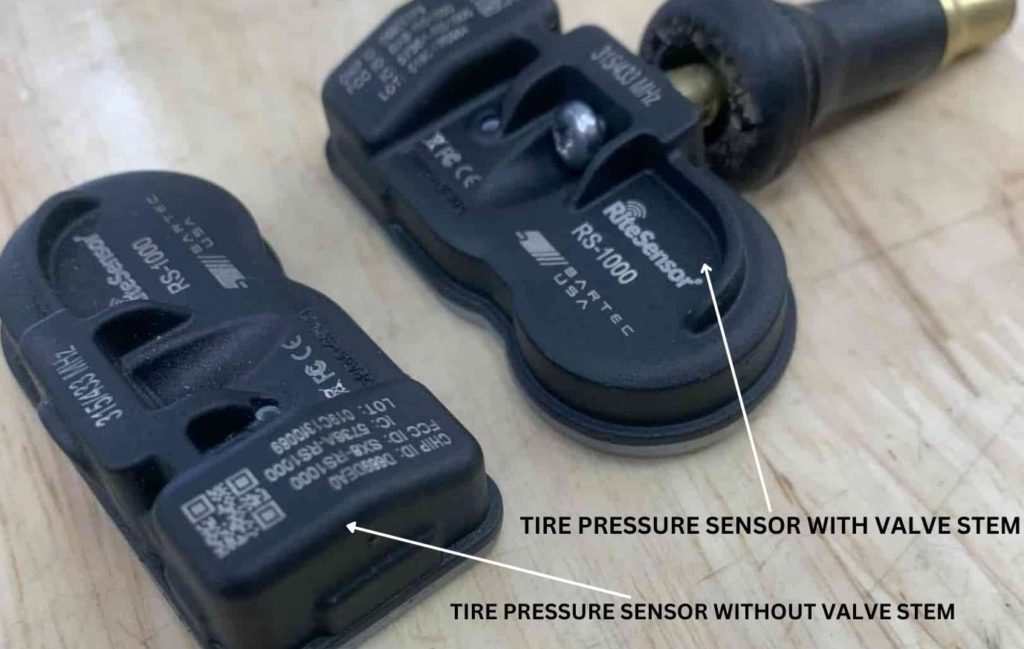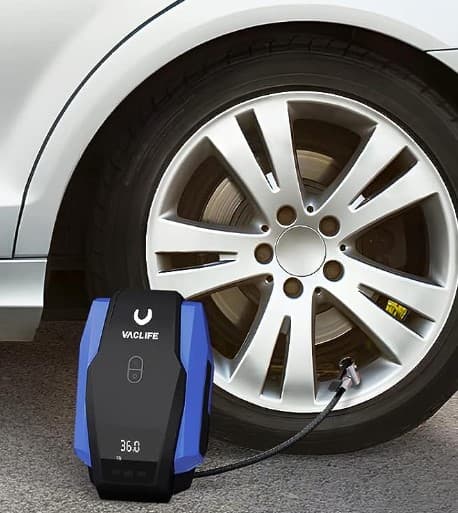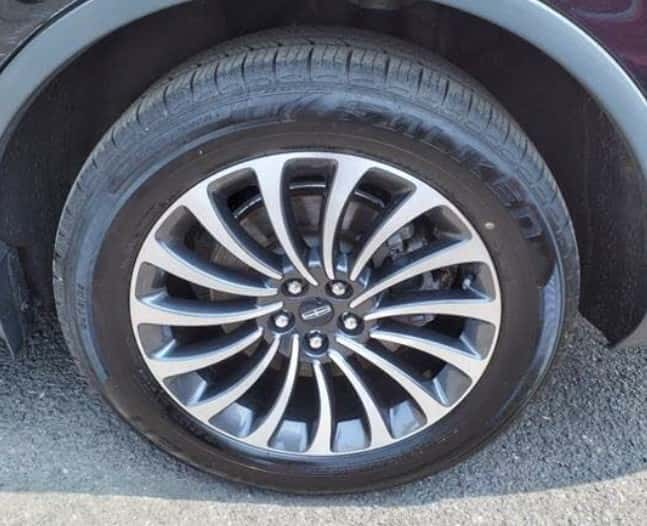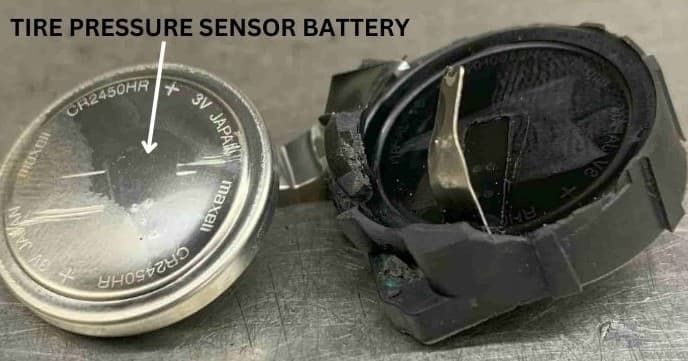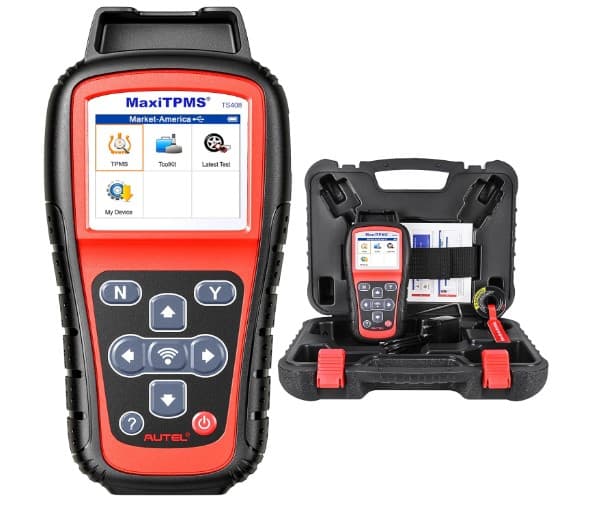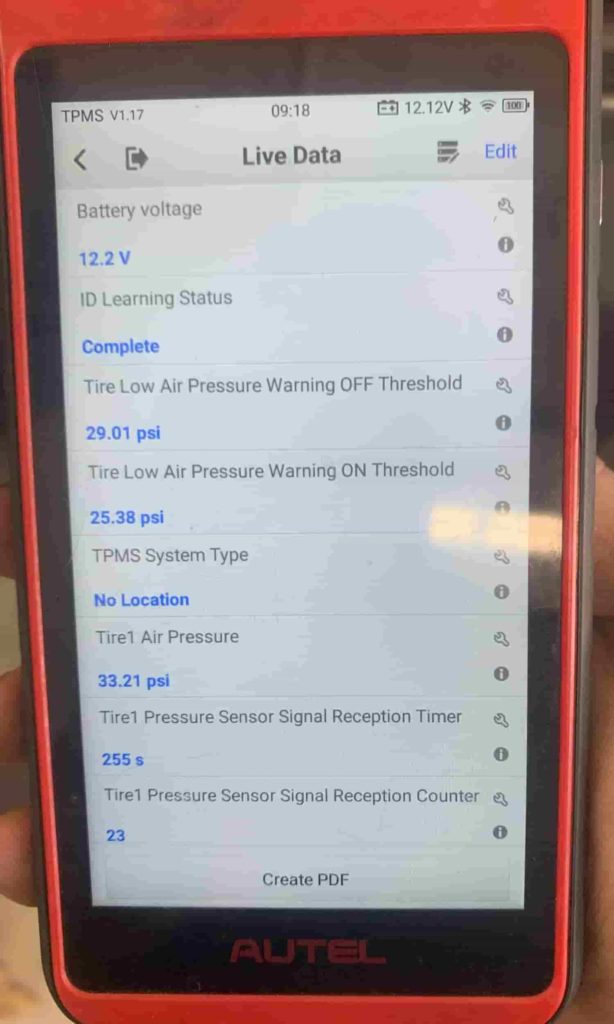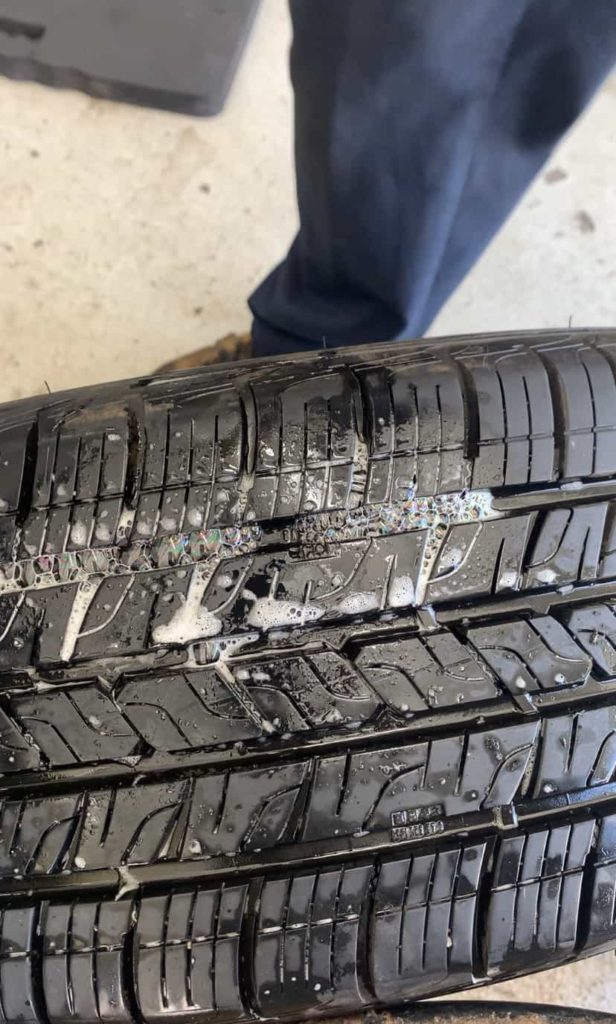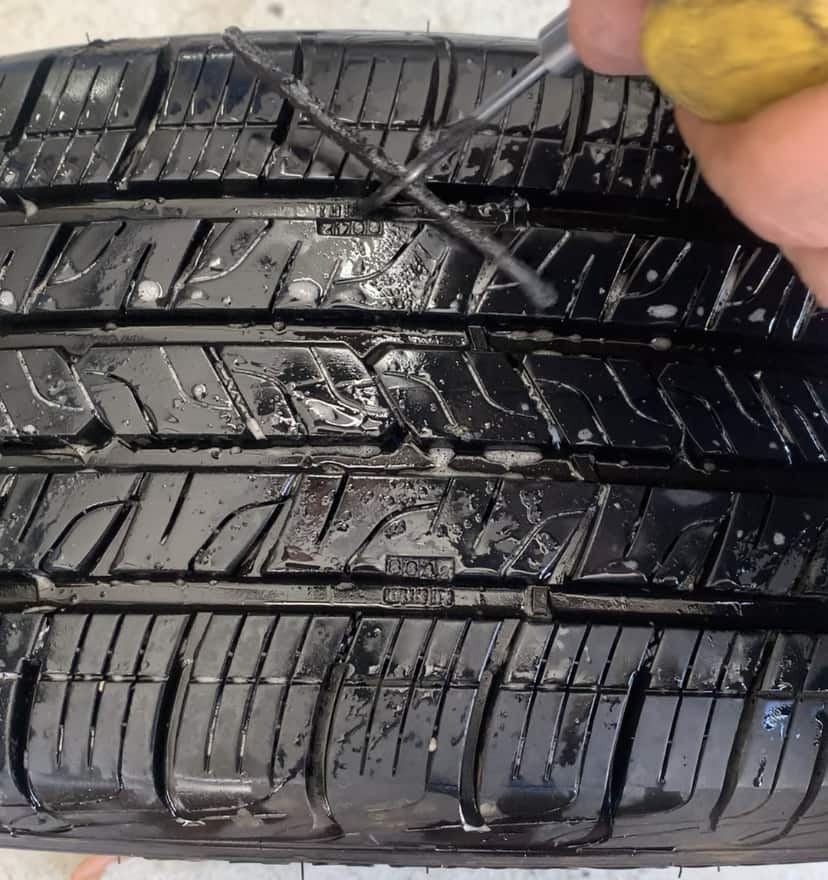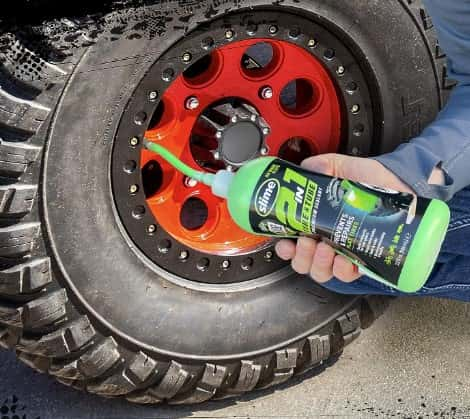What is the Lincoln Aviator TPMS?
The tire pressure warning light on the Lincoln Aviator serves as the end signal generated by its Tire Pressure Monitoring System (TPMS) when there’s either insufficient air in the tires or a malfunction within the system itself. The TPMS comprises three essential components: pressure sensors in the tires, a TPMS receiving unit, and the Lincoln Aviator ECM.
How Does the Lincoln Aviator TPMS Works?
Sensors for Tire Pressure: Concealed within each tire of the Lincoln Aviator, a sensor is mounted to the valve stem’s base. You can’t see the sensor without removing the tire from its wheel (trust me, it’s there). This sensor is in charge of gauging both the pressure and temperature of its corresponding tire. It essentially consists of a circuit board, a battery, and an antenna, all encased in a little plastic shell.
Transmission of Sensor Data: Once the Aviator’s speed crosses the 20 MPH threshold, the sensors activate and begin to transmit data using Radio Frequency transmission (RF). The vehicle utilizes two transmission protocols, 315 Mhz and 433 Mhz.
Module for Receiving TPMS Data: Inside the Aviator, there’s a micro-computer, known as the TPMS receiver module, tasked with gathering and accepting data from each of the tire pressure sensors. This module scrutinizes the data for any discrepancies or errors before forwarding it to the Engine Control Module (ECM).
Engine Control Module (ECM) of Lincoln Aviator: Serving as the main computational hub of the SUV, the ECM aims to ensure optimal vehicle operation. It evaluates the data sent from the TPMS receiver and checks if the tire pressure and tire temperature are within acceptable limits. A dashboard warning light is activated if the readings are off.
Low Tire Pressure Indicators: The standard indicator for low tire pressure in the Lincoln Aviator is a yellow exclamation mark. In addition, the dashboard information display screen may display messages such as “TIRE PRESSURE LOW,” “TIRE PRESSURE MONITOR FAULT,” or “TIRE PRESSURE SENSOR FAULT.” Trailer tire warnings are also available if a TPMS-equipped trailer is attached.
Self-Check Capability: The TPMS in the Lincoln Aviator also features a self-diagnostic function. Should there be a communication glitch between any of the components (sensors, TPMS receiver, or ECM), the yellow exclamation point tire light will flash for approximately a minute and remain illuminated until the issue is fixed, signaling a TPMS malfunction.
How to Reset the Lincoln Aviator Tire Pressure Light
Park the Lincoln Aviator on an even terrain.
Visually examine each tire to confirm that everything seems fine.
Evaluate and adjust the tire pressure to align with Lincoln’s suggested cold pressure values.
Drive the SUV briefly (at least 2 minutes), ensuring your speed surpasses 20 MPH.
How to Train the Lincoln Aviator Tire Pressure Sensors
The process for resetting the tire pressure light in the Lincoln Aviator differs from the tire pressure sensors retraining procedure. You should follow the retraining process after any form of tire or wheel maintenance, including tire rotations, balancing, or alignments. The primary objective of training or retraining the sensors is to allow the Aviator’s main computer (ECM) to accurately identify each tire’s position on the vehicle and display the correct data on the main information screen. For instance, when tires are rotated, the rear tires move to the front, requiring the ECM to be updated to recognize this change.
Engine OFF: Switch the Lincoln Aviator engine OFF.
Engine Off, Electrical On: Double-click the start button without applying the brake, or twist the key to the ACC position. You’re aiming for vehicle electronics to be ON while the engine stays OFF.
Hazard Lights Sequence: Hit the hazard button six times, toggling it on and off three times. ON-OFF, ON-OFF, ON-OFF
Access Reset Mode: You will hear a single horn beep and see a screen message saying that the Aviator is in “RESET MODE”.
Left Front Tire: Exit the vehicle and unscrew the cap from the valve of the front left tire. (Driver side front tire)
Release Air from Left Front Tire: Depress the valve to let air escape until the horn sounds, confirming the tire’s location. Once the horn beeps, the ECM has registered that tire in that position.
Right Front Tire: Head to the front right wheel (passenger front tire), unscrew its valve cap and begin deflating until the horn beeps.
Right Rear Tire: Navigate to the rear right wheel (passenger side rear), remove its valve cap, and release air until the horn beeps.
Left Rear Tire: Move to the rear left wheel (driver side rear tire), unscrew its valve cap, and continue to deflate until the horn sounds.
Completion of Training: If all steps are done correctly, a message reading “Training Complete” will show up on the Aviator display screen.
Inflate All Tires: Refill each tire to its recommended pressure. Only Adjust the tire pressure when the tires are cold.
Drive Briefly: Drive the Aviator for at least a few minutes, making sure to go faster than 20 mph.
Lincoln Aviator Training Tire Pressure Sensor TIPS:
💡If the horn does NOT beep after completing step 3, restart the full procedure. (Toggle the power a couple of times (on-off, on-off), drive the Aviator a few minutes, and start at step 1 again.)
💡It’s imperative to strictly adhere to the set order of steps for your Lincoln Aviator. (LF tire, RF tire, RR tire, LR tire)
💡Should you encounter two horn beeps after any of the steps, you must start the reset process anew.
How to Check the Current Tire Pressure in the Lincoln Aviator
Press the OK button on the right side of the steering wheel
Scroll Up or Down to view current tire pressures.
2022 Lincoln Aviator Tire Pressures
TIRE SIZE | FRONT PSI | REAR PSI |
255/60R19 | 35 | 35 |
255/55R20 | 34 | 38 |
275/45R21 | 32 | 39 |
275/40R22 | 38 | 42 |
Different Lincoln Aviator Tire Pressure Alerts
"TIRE PRESSURE LOW"
This cautionary message points out that a minimum of one tire has insufficient air and should be filled to the advised pressure standards.
"TIRE PRESSURE MONITOR FAULT"
This warning indicates that a fault or irregularity in the tire pressure monitoring system is leading to the flashing of the low tire pressure indicator.
"TIRE PRESSURE SENSOR FAULT"
This cautionary message suggests that at least one tire pressure sensor is not effectively interacting with the TPMS receiving unit or ECM.
rEASONS THE lINCOLN aVIATOR lOW tIRE pRESSURE iNDICATOR mAY tURN oN:
Tires below recommended pressure levels
Tires inflated beyond capacity
Leaking tires
Unmonitored wheel due to missing sensor (e.g., during spare tire use)
Weak or malfunctioning TPMS sensor battery
TPMS receiver or ECM not functioning properly
Electromagnetic disturbances from surrounding devices or vehicles using similar radio frequency bands
Changes in atmospheric conditions or altitude
Vehicle overloaded
Using tire chains
Dense window tinting
lINCOLN aVIATOR tIRE pRESSURE sENSOR bATTERIES
In a Lincoln Aviator, every tire—excluding the spare—has its own tire pressure sensor. Each sensor is essentially a miniature electronic circuit board that includes a transmitter and is powered by a small silver-oxide battery. The whole assembly is encased in plastic, and because of this design, it’s not possible to just change or recharge the battery when it depletes. Instead, both the sensor and its associated valve stem must be swapped out. The usual life expectancy of these tire pressure sensors is between 5 to 10 years, or up to 150,000 miles.
Troubleshooting the Lincoln Aviator Low Tire Pressure Light: 6 Solutions
At times, the tire pressure indicator on your Lincoln Aviator might stay illuminated even after resetting the TPMS or re-training the tire pressure sensors. Understandably, this can be aggravating! Below, we’ve outlined 6 potential reasons and their corresponding solutions for such occurrences.
SOLUTION 1: SIGNS OF A LEAKING TIRE
If the tire pressure alert is triggered, begin by understanding the root cause. Are the tires all deflated? This could stem from climatic changes or natural air pressure loss. Or is one tire specifically showing low pressure while the others appear normal? Do a visual examination of each wheel and tire to look for anything obviously wrong and then continue with these steps:
Don’t exclusively depend on the vehicle’s inbuilt tire pressure monitor; hand-check the pressure in every tire to pinpoint any deflated ones.
Utilize an air pump to change and correct the tire pressures, and remember to verify the pressure post-inflation.
Drive your Lincoln Aviator at a speed exceeding 20 Mph for a few miles.
⏩OUTCOME: Should the tire pressure warning deactivate post the aforementioned steps but returns later, regardless of the lapse in time, it signals a probable air leakage in one of the tires or wheels. For a detailed way to find the leak’s source, see solution 6.
SOLUTION 2: A GUIDE TO RESETTING THE LINCOLN AVIATOR COMPUTER
In the same way you’d restart or unplug a frozen computer, the Lincoln Aviator’s computer system can be reset. This computer, referred to as the ECM or ECU, is continuously capturing data from all of the vehicle’s sensors. There are predefined ranges for each sensor’s data in the ECU/ECM. If the incoming data falls outside these ranges, a warning light is activated to notify the driver, indicating a DTC or Diagnostic Trouble Code. An example of this is the activation of the low tire pressure light. Each DTC detected is saved in the Aviator computer’s memory, whether it’s temporary or permanent. Just as a personal computer can experience errors and need a restart, the ECM can too. To reset the Lincoln Aviator’s ECM and clear the temporary DTCs, follow the steps below:
Ensure the tires are inflated to the appropriate cold pressure levels.
Switch off the engine and ensure all electronic systems are off (like lights, radio, etc.).
Disconnect the negative terminal of the main 12-volt battery.
Wait for a moment.
Reattach the negative battery terminal to the battery.
Drive at a consistent speed of 50 Mph for around 30 minutes to recalibrate the sensors.
⏩SUMMARY: After you’ve reset the battery of the Aviator, check if the tire pressure light turns off and stays off after driving. If it comes back on, there could be a tire leak or a communication error between the ECM and a tire pressure sensor. Ensure there isn’t a tire leak before moving to diagnose the sensors in Solution 3.
SOLUTION 3: HOW TO DIAGNOSE A FAULTY TIRE PRESSURE SENSOR
Upon completing steps 1 & 2, if you believe there’s an issue with a tire pressure sensor, you’ll need a TPMS programming/diagnostic tool. I’ve consistently relied on the Autel TPMS tools and can attest to their effectiveness and precision. To pinpoint any malfunctioning tire pressure sensors, carry out a test using a TPMS programming device. Here’s how to do it:
Plug the TPMS calibration tool into the Lincoln Aviator’s OBD2 port, located beneath the steering column.
Initiate the testing of tire pressure sensors as directed by the device.
Position the TPMS tool near the valve stem of the front-left tire and press the “trigger” or “test” option. Be sure you are putting the tool as close to the valve stem as possible.
Wait briefly for the tool to report its findings.
Follow the same steps for each of the other three tires. Make sure to test the sensors in the order the tool requests.
⏩ RESULT: Once all the sensors have been checked, the TPMS programming device will provide a comprehensive report on their condition. A replacement is needed if a sensor is unable to communicate with the tool or if the tool indicates a low or exhausted battery in a sensor.
SOLUTION 4: RESETTING AN INACTIVE TPMS SENSOR
Tire pressure sensors can become dormant, leading to the illumination of a low tire pressure warning. To reactivate such a sensor, adhere to these instructions:
Depress the valve stem to let air out of the tire linked to the inactive sensor.
Reduce the tire pressure by about 15-20 Psi.
Inflate the tire, adding an extra 5 Psi to its usual recommended pressure. So, if the standard pressure is 34 Psi, pump it up to 39 Psi. (this is only temporary)
Drive the Lincoln Aviator for several minutes, ensuring your speed surpasses 20 Mph. (Steer clear of highways or very high speeds.)
Once parked, release the additional 5 Psi to revert to the tire’s suggested pressure.
Check and verify all tire pressures.
⏩ POINT TO NOTE: We recommend following this solution if resetting or retraining the Lincoln Aviator tire pressure sensors was unsuccessful. Follow this solution and then follow the TPMS reset/training steps again.
SOLUTION 5: UNDERSTANDING TIRE PRESSURE ALERTS IN VARYING TEMPERATURES
For those living in regions experiencing notable temperature dips at night or significant seasonal temperature changes, you may have observed the low tire pressure warning lighting up when you start your Lincoln Aviator for the first time of the day. Yet, as temperatures climb and the tires get warmer throughout the day, the tire alert light often turns off on its own. While this is a common phenomenon, it can be avoided.
⏩ ACTION STEP: It’s crucial to check and adjust your tire pressures when they’re cold. Ideally, this means when your Lincoln Aviator has remained stationary for at least 3 hours or has only been driven for less than a mile. By adhering to this guideline, you can ensure precise tire pressure settings.
SOLUTION 6: HOW DO YOU FIND THE SOURCE OF A TIRE LEAK?
If you’ve tried the aforementioned solutions and deduced that one of your tires is losing air, here’s how to pinpoint the source of the leak. Essentials: Water, Soap or window cleaner, a spray bottle, and a tire inflator.
Inflate the tire to a minimum of 35 Psi.
Blend water and soap in the spray bottle to create a mixture. Alternatively, a window cleaner like Windex will work just as well.
Adjust the Aviator’s wheel positioning for convenient spraying – if it’s a front tire, turn the steering wheel for a better view of the tire.
Douse the tire liberally with your soapy concoction.
Observe the drenched tire for tiny air bubbles emerging.
⏩ WHAT IT MEANS: The bubbles emerging on the tire indicate the precise spot where air is escaping. Use chalk to mark this leak site to facilitate its repair later on.
Common Lincoln Aviator Tire Pressure Questions
How Do Temperature Changes Affect Tire Pressure?
It’s a little-known fact that tire pressure in vehicles like the Lincoln Aviator can be highly sensitive to temperature changes. This is often the cause for the tire light to turn on. Specifically, for every 10°F decline in the ambient temperature, the tire’s air pressure can reduce by about 1-2 psi. So, if you experience a temperature transition from a warm 75°F day to a chilly 40°F night or morning, there’s a potential for a 3.5-7 psi drop in tire pressure. This will certainly trigger the Lincoln Aviator low tire pressure light.
How to Manually Check the Lincoln Aviator Tire Pressure
Find the Recommended Pressure: Check the white or yellow sticker on the inside of the driver side door to determine the cold recommended tire pressure for your Lincoln Aviator.
Equip Yourself: We suggest using a digital tire pressure gauge because they are accurate and easy to read.
Time It Right: For the most accurate results, measure the air pressure when your tires are cold – that means either after the Aviator has been idle for at least three hours or has been driven less than a mile. Also make sure you park on level ground
Execute the Check: Unscrew the valve cap from a tire, press the gauge onto the valve, and note the reading.
Adjust as Needed: Inflate or deflate the tire as required to align with the recommended pressure.
Repeat Process: Repeat the same process on the other 3 Aviator tires and don’t forget to put the valve stem caps back on.
Can You Disable the Tire Pressure System in the Lincoln Aviator?
No. Any alterations to the Lincoln Aviator’s tire pressure system will cause the low tire pressure indicator to malfunction.
How to Manage Tire Pressure Sensors When Changing Wheels or Tires?
When changing the tires on your Lincoln Aviator, the only requirement is to train the tire pressure sensors. However, if you opt for new wheels or rims, you can either transfer the existing tire pressure sensors from the old set to the new one, or buy and install a fresh set of 4 TPMS sensors and then program them to the Aviator’s ECM using a TPMS programming/diagnostic tool.
Will a Change in Altitude Affect the Tire Pressue?
Altitude significantly impacts the tire pressure of the Lincoln Aviator. As you ascend 1,000 feet from sea level, there’s roughly a 3.5% decrease in atmospheric pressure. This decrease can lead to an approximate rise of 1 Psi in tire pressure. Thus, if you navigate your Aviator up a terrain gaining an elevation of 4,000 feet, your tires might experience an uptick of around 4 Psi.
Is Driving the Lincoln Aviator With the Tire Light on Safe?
It’s not advisable to operate the Lincoln Aviator when the low tire pressure indicator is illuminated. This warning light signifies an issue, whether it’s due to decreased tire pressure or a communication problem between a tire pressure sensor and the vehicle’s ECM. Before proceeding further, halt your journey and conduct a hands-on inspection of the tire pressures.
Why is the Lincoln Aviator Tire Pressure Light Flashing?
If the tire light on your Lincoln Aviator blinks, it signifies an issue with the tire pressure monitoring system. This often arises when there’s a communication breakdown between the Lincoln Aviator’s TPMS receiver module, or ECM, and one or more of the tire pressure sensors. Instances like driving with the spare tire, which lacks a tire pressure sensor, or a low or depleted battery in a TPMS sensor can trigger this. For such issues, please refer to Solution 3 mentioned earlier.
Can Tire Plugs Dependably Repair Punctures?
Indeed, tire plugs serve as an effective method to mend a puncture located on the tire’s tread. However, avoid using them on entirely worn treads or on the tire’s sidewall.
Everything in this article is applicable to all Lincoln Aviator models and versions including the Lincoln Aviator Black Label Grand Touring Plug-in Hybrid, Black Label, Grand Touring Plug-in Hybrid, Reserve, and Standard.
Please note that this blog post contains Amazon affiliate links. This means that if you make a purchase through one of these links, we at TPMSRESET.COM may earn a small commission at no extra cost to you. We only recommend products that we personally use and believe in. Thank you for supporting us.

